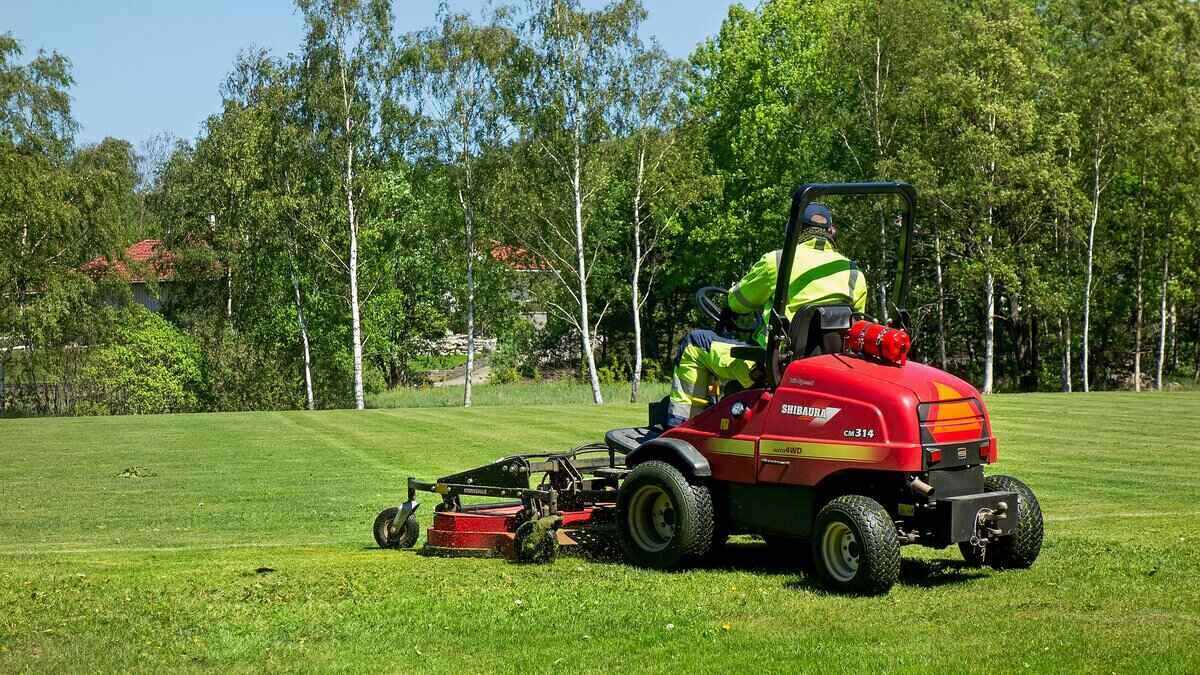
Lawn care is a risky business. Mowers and trimmers are designed to cut, and they do so with ruthless effect. Avoiding injury on the job is mainly a matter of discipline. When long days under the hot sun tire you out, it’s crucial to focus on keeping yourself and your crew safe.
In this article, we’ll cover ways that you and your crew can stay safe no matter what piece of lawn care equipment you are pushing, riding, or wielding. We’ll also offer more specific safety tips for the most common tools of the landscaping trade:
- All-purpose lawn care safety tips
- Lawn mower safety tips
- String trimmer safety tips
- Leaf blower safety tips
- After-work safety tips
All-Purpose Lawn Care Safety Tips
Here are some tips to help you avoid a trip to the emergency room while operating lawn care equipment.
Pay attention
The easiest way to keep yourself safe when operating lawn equipment is to always pay attention. Small bits of yard debris can become dangerous missiles when run over with a mower. Keep your eyes on the lawn at all times.
Listening to music or a podcast can help your day go quicker and drown out the sound of your equipment. While this seems like a good idea, headphones or earbuds are no substitute for proper hearing protection. When listening to music, make sure you can hear your surroundings. A vocal warning from a crew member or passerby could save your life.
Experienced pros can become too relaxed around machinery. It’s important to remember that mowers and string trimmers are designed to cut anything they come into contact with. By maintaining a sense of respect for bladed tools, you can avoid serious injury.
Wear proper apparel
Always wear clothes that protect your body. Long sleeves, even in the summer, can greatly reduce the risk of cuts and burns. Face coverings, like masks or bandanas, can keep you from inhaling airborne pollen and debris.
Closed-toed shoes are a must, but a good pair of work boots can’t be beat. Check out our roundup of the Best Work Boots.
Safety glasses and earmuffs — or those big old-school headphones — protect your eyes and ears when operating heavy machinery.
Why do you need protection for your ears? A weed-eater can whip a piece of glass at your head, and the roar of a leaf blower can be deafening (which is why some cities have banned or restricted their use).
Keep a well-stocked first-aid kit
While a basic first aid kit is required by law, it’s important to tailor yours to the type of injuries you or your lawn care crew might experience. The most common lawn care injuries include cuts, abrasions, and chemical burns from fertilizer or herbicide.
Cuts come in all sizes and severities so a lawn care first aid kit should include bandages and gauze wraps of various sizes. But that’s just for starters. Some things you might not think to include in your lawn care first aid kit if you stick just with the OSHA rules:
- On your feet all day? Toss some moleskin in your kit to prevent and treat blisters.
- Forgot the sunscreen? Keep aloe vera lotion on hand as it can save you a good deal of pain.
Pro Tip: Always restock items when they’re halfway gone, so you’re never caught in a situation where you don’t have what you need.
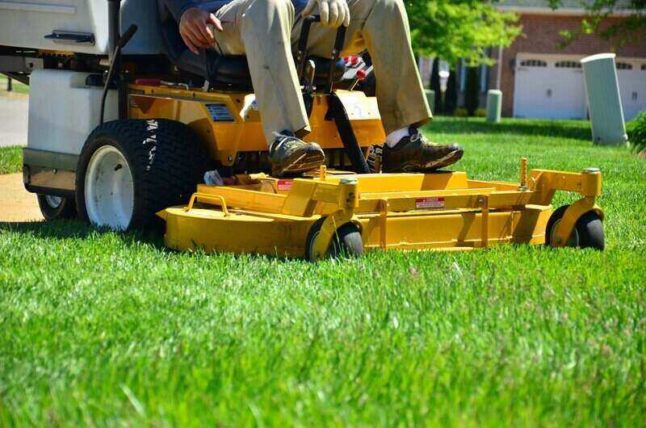
Lawn Mower Safety Tips
A lawn mower is the most basic tool for any landscaping professional. Whether you use a push mower, a riding mower, or a zero-turn, it’s important to keep safety in mind.
Mowers can cause a variety of injuries. Cuts, burns, and amputations can be caused by improper contact with the machine, while thrown debris can become dangerous missiles.
Here are some tips for avoiding injury when using a mower.
Beware of objects as missiles
The most common lawn mower injuries occur when an object is thrown by the blades. Small items like gravel can cause serious injury when striking you — the lawn mower operator — or bystanders. Large rocks can dislodge the blades themselves, creating a deadly flying object.
Before mowing, always check the lawn for loose items such as children’s toys, rocks, and waste (such as bottles or cans) and remove all of these. Make a note of where objects like large rocks, curbs, steps, and other hard surfaces may come in contact with the blades, and avoid mowing those areas.
Make sure all crew members are wearing eye protection when any mower is in operation. Ride-on and zero-turn mowers reduce the risk of injury to the operator by placing the driver above the path of thrown objects.
Always stop mowing when homeowners or passers-by come within 50 feet of the mower.
Have bandages for cuts
Cuts can occur easily when making repairs or adjusting the blades of your lawn mower. Keeping your mower blades sharp will give you a more consistent cut. Wear leather or synthetic safety gloves at all times when handling or replacing blades.
Engine repair can also result in cuts. Always make sure the motor is fully powered down when examining, repairing, or removing grass clippings and yard debris.
If you do get cut while operating or handling your mower, power down the machine immediately. Clean your wound with soap and water, apply antibiotic ointment, and cover your cut or scratch with a properly sized bandage. For deep cuts or gashes, apply firm pressure and seek medical attention.
Reduce your risk of burns
Gas engines become hot when used for any period of time. Though gloves and sleeves are your best line of defense against burns, it’s best to avoid contact with the engine entirely.
Mowers with protective coverings over mechanical parts are ideal. Check out our guides to the best push lawn mowers, zero-turn mowers, and riding mowers. Consider using battery-powered mowers, which run significantly cooler and reduce burn risk.
Wear work boots to cut risk of amputation
With blades spinning at 3,000 RPM, contact with body parts can prove disastrous — 30% of direct-contact injuries result in amputation. Larger bones can be fractured or broken by blades or heavy mowers.
Work boots are the best protection from amputations. Lower extremities are by far the most vulnerable body parts, as they’re closer to the mowing deck.
When using a push mower, avoid steep slopes and never pull backward toward your feet. Keep an eye on your surroundings when riding mowers.
Don’t operate within 50 feet of another person, and don’t let passengers hop on the lawn mower with you.
Maintain your lawn mower
Always consult the manufacturer’s recommendations when repairing or maintaining lawn care equipment. Use proper fuel, keep blades sharp, and regularly clean interior mechanics. This will go a long way toward keeping you and your crew safe.
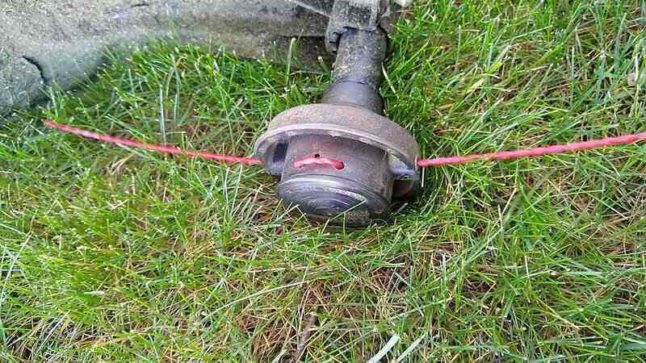
String Trimmer Safety Tips
A string trimmer, also known as a weed whacker or weed eater, is the best tool to keep a lawn’s edges sharp. Like all power tools, it can be dangerous to operate without proper care.
Use the right string
String trimmers are not a one-size-fits-all tool. Lines come in different thicknesses, weights, and spool sizes designed for different types of usage. Manufacturers will generally recommend buying their own brand of replacement string, but the owner’s manual should give the specs you need to choose the best brand for your budget.
Never replace your string trimmer line with a blade or chain attachment. While many aftermarket blades are available, they can be extremely hazardous. Unless attachments are manufacturer-approved for your trimmer, they can come loose during operation.
Using a blade or chain near a concrete curb or asphalt driveway can cause serious bodily harm. Many manufacturers make convertible trimmers or separate brush cutters that safely allow blade use.
Wield a weed whacker with care
Much like a mower, you should only operate a string trimmer after taking the proper precautions. Check that the shaft is firmly connected to the ends. A loose or wobbly shaft can be indicative of a mechanical issue.
Clear your path of debris and other objects before starting. Take special care when maneuvering around large objects like rocks, statues, and water features.
Using a weed eater on wet grass isn’t recommended, but inclement weather or sprinklers can make it an unavoidable task. Move slowly to avoid slipping. Wet grass can bend instead of breaking off clean, so double check your work in rainy conditions.
Only operate the trimmer facing away from you, and do not remove the guard. Never operate when someone is standing in front of the trimmer, and cease operation when passers-by come too close.
Wear safety goggles, gloves, boots, long sleeves
Like with most lawn care equipment, proper apparel can keep you safe when operating a weed eater. Safety glasses or goggles, long sleeves, gloves, and solid boots can keep you and your crew safe when a string trimmer is being used.
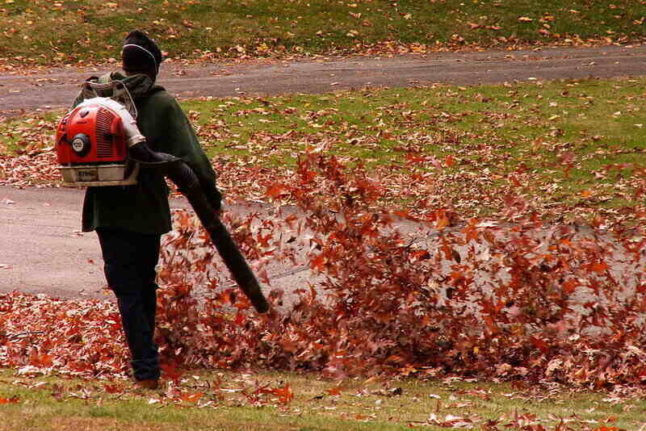
Leaf Blower Safety Tips
A leaf blower may seem like a relatively safe tool to use when compared to a tool designed for cutting or trimming. Though not quite as dangerous as a mower or brush cutter, a leaf blower can still harm you — your lungs and especially your ears.
Here are some tips to safely operate a leaf blower:
Use a blower for leaves or grass
Leaf blowers can be used to clean a yard of grass clippings, thatch, and, of course, leaves. However, there are substances you shouldn’t attempt to clean with a leaf blower.
Plaster dust, and other fine particles such as dry topsoil, can cause breathing problems when inhaled. Though you may be wearing face protection, a cloud of thick dust can hang in the air for several minutes and cause issues for pedestrians.
It may seem convenient to move heavy dirt or pea gravel with a blower, but a rock or pebble blown at the wrong angle may become a flying projectile.
Watch your balance on ladders
A blower may be a quick way to clean a roof or gutter of leaves and debris, but using one while on a ladder is a bad idea. A backpack-style blower can leave you unbalanced at any height, and the force of air may be enough to send you crashing to the ground.
Clear the area of stones, toys, other items
Like with a mower or trimmer, you should always clear the area of miscellaneous objects before blowing. Heavy leaf cover might make it difficult to see stones, toys, or other items, so go slowly and don’t operate your blower when someone is in front of you.
Follow manufacturer recommendations on repairs
Gas-powered leaf blowers have the same mechanical hazards as any other small engine. Consult the manufacturer’s recommendations before making repairs.
Protect your eyes, ears, lungs
Proper safety equipment is just as important with a leaf blower as a mower or trimmer. Because of the propensity to create flying dust, pollen, and debris, eye protection and masks are especially important. Ear protection will help you keep your hearing intact after hours of leaf blowing every day. Finally, gloves, sleeves, long pants, and good boots are always a benefit when doing outdoor work.
Know local noise restrictions
Because leaf blowers are especially loud, many cities and towns have restrictions on the hours when they can be used. Check out the noise ordinances in the cities where you operate.
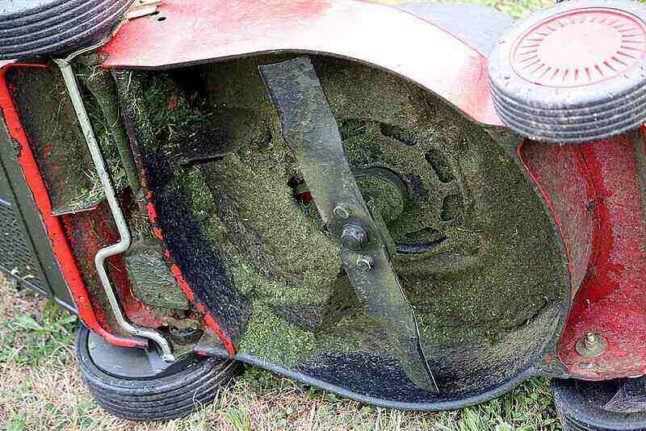
After-Work Safety Tips
At the end of a long day, it can be tempting to toss your lawn care tools in the truck and call it a night. However, improper storage and maintenance can prove dangerous in the long run.
Here are some tips on keeping your equipment in top shape:
Store your lawn equipment properly
Whether you use a pickup, open trailer, or box truck, keeping your equipment organized and secure can keep everyone safe. Make sure all equipment has a designated place in your trailer or truck bed and is belted down tight.
String trimmers should be stored horizontally or hung with the engine on top. Machines like mowers, dethatchers, and powered aerators should have their wheels locked or chocked to prevent movement.
Improper storage can lead to dangerous cargo shifts when the truck is moving. In open trailers or pickup beds, this can create a road hazard for you and vehicles behind you.
In box trucks and closed trailers, this can lead to falling equipment the next time you open the cargo area. Ratchet straps and bungees are a good investment to protect your crew and everyone else on the road.
When you wrap up for the evening, make sure to lock up your equipment in a safe, dry location. Why a dry location? Rust from excess moisture can degrade fasteners and dull blades.
Maintain your equipment as recommended
Before you finish for the evening, refuel your equipment according to manufacturer recommendations. Different tools require different types of fuel and oil, so always consult the manual when refueling new machines.
Disconnect spark plugs when refueling, and wait at least two minutes before ignition to let fumes evaporate.
Make sure batteries are charging before you turn in for the day. Check your string trimmer spools and replace them as needed. If you experienced any mechanical problems during the workday, double-check the machine in the evening, even if you “fixed” the issue on-site.
Spending time checking your equipment after working all day may feel like a chore, but it’s always better to put in the extra time to make life easier for you in the morning. Making sure your tools are clean and blades are sharp today can save you the headache of on-site maintenance tomorrow.
Lawn Care Safety Should Be Job 1
Safety First should be a core value in any workplace, and as lawn care pros, our workplaces vary every day by size, degree of difficulty, weather hazards (extreme heat, high wind, or storms). That makes safety more of a challenge because the work environment is ever changing.
That’s how this safety tips checklist can help you.
If Safety First is a guiding principle in factories, the Boy Scouts motto of Be Prepared should also be top of mind for lawn care pros. That helps ensure we’re focused on safety and ready with first aid when accidents happen — and they will.
Main Photo Credit: W.carter / CC0 / via Wikimedia Commons